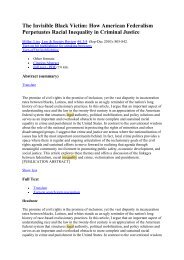Ski – resort and regional development: profile of visitors ... - E-Journal
Ski – resort and regional development: profile of visitors ... - E-Journal
Ski – resort and regional development: profile of visitors ... - E-Journal
You also want an ePaper? Increase the reach of your titles
YUMPU automatically turns print PDFs into web optimized ePapers that Google loves.
Predicting residents’ perceptions <strong>of</strong> cultural tourism attractiveness<br />
model is a valuable tool for a systematic analysis <strong>of</strong> city tourism space <strong>development</strong> as it<br />
permits a focus on different types <strong>of</strong> attractions <strong>of</strong> a city. Oppermann, Din, <strong>and</strong> Amri (1996),<br />
Ashworth (1989), <strong>and</strong> Ritter (1986) propose their own versions <strong>of</strong> city models that will ensure<br />
sustainable city tourism.<br />
Such endeavors require accurate assessments <strong>of</strong> visitor needs <strong>and</strong> perceptions for destinations<br />
to determine where they are meeting the needs <strong>of</strong> their target <strong>visitors</strong>, <strong>and</strong> identify areas that<br />
additional efforts are needed. The quality <strong>of</strong> services, facilities <strong>and</strong> attractions <strong>of</strong> destinations<br />
in the eyes <strong>of</strong> <strong>visitors</strong> will usually be important factors in creating an image which not only<br />
helps to attract new <strong>visitors</strong>, but also encourages past <strong>visitors</strong> to return to the destination<br />
(Joppe, Martin, & Waalen, 2001).<br />
Ross (2007) surveyed residents <strong>of</strong> an Australian city to measure their perceptions <strong>of</strong> the<br />
impacts <strong>of</strong> tourism on city facilities <strong>and</strong> on individual <strong>and</strong> community life. The results show<br />
that tourism had positive effects on hospitality facilities, leisure <strong>and</strong> entertainment services,<br />
as well as business opportunities. Several negative impacts were found such as increased<br />
living costs <strong>and</strong> crime rate. In addition, the study revealed that tourism has greater impact on<br />
the community as a whole rather than on the individual level.<br />
Achana <strong>and</strong> Avgoustis (2001) used the importance performance analysis (IP) to assess<br />
Indianapolis’s position as a potential international tourism destination. IP is a research<br />
technique <strong>of</strong>ten used in strategic quality <strong>development</strong> <strong>of</strong> the salient features <strong>of</strong> services <strong>and</strong><br />
products provided to customers (Martilla & James, 1977; Hawes & Rao, 1985; Dolinsky,<br />
1991; Almanza, Jaffe, & Lin., 1994; Go & Zhang, 1997; Joppe et al., 2001). In tourism<br />
destination assessments, it involves a simultaneous examination <strong>of</strong> the assessments by <strong>visitors</strong><br />
<strong>of</strong> both the importance <strong>of</strong> the salient features <strong>of</strong> the services <strong>and</strong> products provided by a<br />
destination, <strong>and</strong> the extent to which the destination is seen by the <strong>visitors</strong> to have performed<br />
to their expectations on those salient features. Achana <strong>and</strong> Avgoustis (2001) concluded that<br />
Indianapolis has certain destination features that could allow it to position itself competitively,<br />
such as: (a) exceptional hospitality to the visitor, (b) high st<strong>and</strong>ards <strong>of</strong> cleanliness <strong>and</strong><br />
hygiene, (c) safety concerns would not be a major preoccupation <strong>of</strong> <strong>visitors</strong>, (d) new <strong>and</strong><br />
unique experiences that differ from other American destinations, <strong>and</strong> (e) diverse <strong>of</strong>fering <strong>of</strong><br />
restaurants. In order to remain competitive, Indianapolis must create a distinctive market<br />
position out <strong>of</strong> its unique comparative advantages.<br />
RESEARCH METHODOLOGY<br />
The following three objectives were established to address the purpose <strong>of</strong> the study: (a) design<br />
a survey to be administered to Indianapolis residents, (b) utilize a number <strong>of</strong> statistical<br />
techniques, including descriptive statistical analysis to detect Indianapolis residents’ demographic<br />
<strong>pr<strong>of</strong>ile</strong>s <strong>and</strong> their perceptions about city services, <strong>and</strong> (c) perform a factor analysis <strong>and</strong> a<br />
regression analysis to determine what factors are more important as predictors <strong>of</strong> Indianapolis’<br />
overall attractiveness as a cultural tourism destination.<br />
Tourism Today - Fall 2007 - Full Paper<br />
129














